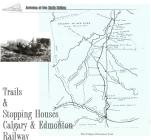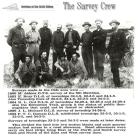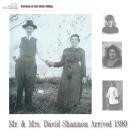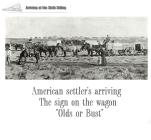1
Government Policy to develop Canada and the North West Territories lead us to the 6th Siding.1 July 1867
Canada 1867
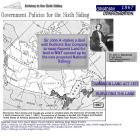
2
Before we continue with our story with David Shannon arriving at the sixth siding, we need to look back to some important policies that led to Shannon's arrival.After confederation in 1867 MacDonald made a promise of a rail line to connect with British Columbia and avoid them joining the United States.
To raise the money he devised Acts of Parliament that were necessary to create markets for the investors in the rail line.
They needed people to settle this vast area known as the North West Territories. To buy products from the eastern-based businesses, keep the railway solvent, and to supply food goods back to the established Provinces
The Red River Valley had been settled for 100 years but there were very few people between B.C and Winnipeg.
Parliament passed Dominion Lands Act of 1872.
The Dominion land policy, in theory, offered free land to homesteaders. In the 1871 land policy, request for homesteads of 160 acres (a quarter-section) were accepted for a fee of ten dollars and a residence requirement of five years. In the Dominion Lands Act of 1872, the residence requirement was reduced to three years in order to compete with similar American offers. The applicant had live on the land for 6 months and farm 40 acres before they could apply for a patent to own the land. While most homesteads were assigned in this manner, some 60 million acres were available by purchase through the joint claims of the CPR, the HBC, and school lands. The survey system designated even-numbered sections as open to homesteads, with the odd-numbered sections being left available for sale. The resulting process of pre-emption, which allowed the homesteader to file an interim claim on adjoining quarter sections, and land sales served to encourage the formation of large farms. The withholding of extensive tracts of land for speculation by the HBC, the CPR, and other colonization companies greatly frustrated potential settlers.*
*Calgary & Southern Alberta / Department of History / the University of Calgary
Copyright (c) 1997, The Applied History Research Group
3
The CPR (Canadian Pacific Railway) was completed to the Pacific coast of British Columbia in 1885.1885
North Western Territory Canada
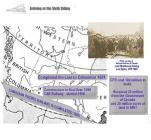
5
Lone Pine Stopping HouseBefore the railways, goods and people were shipped by wagon on the Calgary and Edmonton trail. 10 miles northeast of the sixth siding there was a stopping house Called Lone Pine. Langlais ran it then applied for land under the Dominion Land Act. The trail was rough and it took 4 to 5 days to get to Fort Edmonton. In the winter they often had to change from wheels to sleigh runners at Lone Pine. This was due to less snow from Montana to lone Pine or frequent Chinooks [a warm snow eating wind from the west]
7
Survey CrewThe survey team on the Calgary and Edmonton Rail line
William Bliss, Symonds, Phillip Foster, Cameron, Peter Turner, Bone, Bell, Hale, Norquay, and Simon.
The system of surveying this vast land for settlement was an english system. The system worked with the earths meridians. The 6th siding (Olds) was west of the 5th meridian. Townships were numbered from 1 at the USA border.The 6th siding (Olds) Olds district was 32, 33, and 34 townships. The ranges are numberd starting with 1 west of the mederian. Then each quarter section ( 160 acres) was idenitifed by compass points.
We will have land descriptions and homestead maps throught this exhibit.
8
David Shannon and the C. and E. Railway construction crew in front of the bunk car.1890
Fort Calgary, NWT, Canada
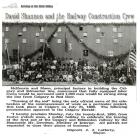
9
Bunk Car:The bunk car was used in the construction of the Calgary Edmonton railway.
Dimensions were 60 feet long. 191/2 feet high, 10 feet wide, capacity 90 men.
Geo. Bathos a settler in the Dog Pound area saw the railway would create opportunity.
According to History of Olds and Area " George Bathos came in from his homestead and ran a stopping house in the remodeled cook house of the railway construction crew. [In Olds]
* The History of Olds and Area 1980 Published by History Committee for the Town of Olds
11
David ShannonIrish born, David Shannon immigrated to Canada after working on building the London underground. He helped build the CPR from Montreal to the Golden Spike at Craigellachie B.C. in 1885.
His railway construction career continued in 1890 where he was the section foreman for the Calgary and Edmonton Rail line.
He decided the sixth siding North of Calgary was the place for his family to settle. He claimed squatters' rights, and then filed a $10.00 fee for his quarter section under the Dominion Lands Act of 1872.
He and his wife built a Soddy (a house made of sod) but after the Calgary and Edmonton rail line was complete in 1891 the CPR purchased the rail line and wanted the Shannon quarter to build the Station house. They swapped quarter sections with the company and continued to make their home in this new land.
As his son Dave remembered, "Father became foreman from Innisfail to Carstairs. The track was pretty soft and the men would build up the track with slabs"
"They were going to name the town "Shannon".
There were three other places on the line with Shannon as a name so father would have to pay for the name changes. He was making 75 cents a day so he declined the offer."
**David Shannon Jr. remembers," A conversation with OHS Archivist G. Wiper
* The History of Olds and Area 1980 Published by History Committee for the Town of Olds
13
Not all the new settlers came by train:According to the History of Olds and Area
*In 1891 John Siverthorn and his family arrived to Olds with his wife and 3 children, after a very arduous year long journey. They traveled by oxen drawn covered wagon from North Dakota trailing their livestock.
He filed for a homestead quarter. [Where the Auction mart stands now 2003]
He took over George Old's store and post office. He expanded the store, and built a new store to rent. The store was also living quarters for the family and provided room and board for people that came to Olds.
Enterprising Silverthorn soon had a log home on the homestead and ended up owning a section of land to the south of the town close to the railway line.
Provincial Archives records contain a letter --- requesting to donate an acre of his land for a school, "Can I do so without affecting my chances of making proof and acquiring patent ... and can I futher release half an acre for a church"
The first school was built on his land and he later donated land for a town cemetery
His daughter Mae said, "my dad was like a gypsy: loved adventures. He loved racing, too, and had the first track for horse racing at Olds. Daughter Florence [Mrs. Fred Shackleton] would ride with him to exercise the horses, but mother refused. She said she had enough of roughing it over the years with him and his gypsy ways".
On April 1, 1892 Siverthorn was officially appointed as the first Postmaster of Olds.
Silverthorn was elected Mayor of Olds in 1912.
* The History of Olds and Area 1980 Published by History Committee for the Town of Olds
